Welcome to our blog post about the stunning and majestic Rocky Mountain horse breed!
If you’re a horse lover, then you’ll want to read on as we explore everything there is to know about this incredible equine.
With their distinctive looks, gentle temperament, and exceptional versatility, it’s no wonder that Rocky Mountain horses are such a popular choice for riders across North America.
So, saddle up, and let’s hit the trail together as we delve into the world of the Rocky Mountain Horse!
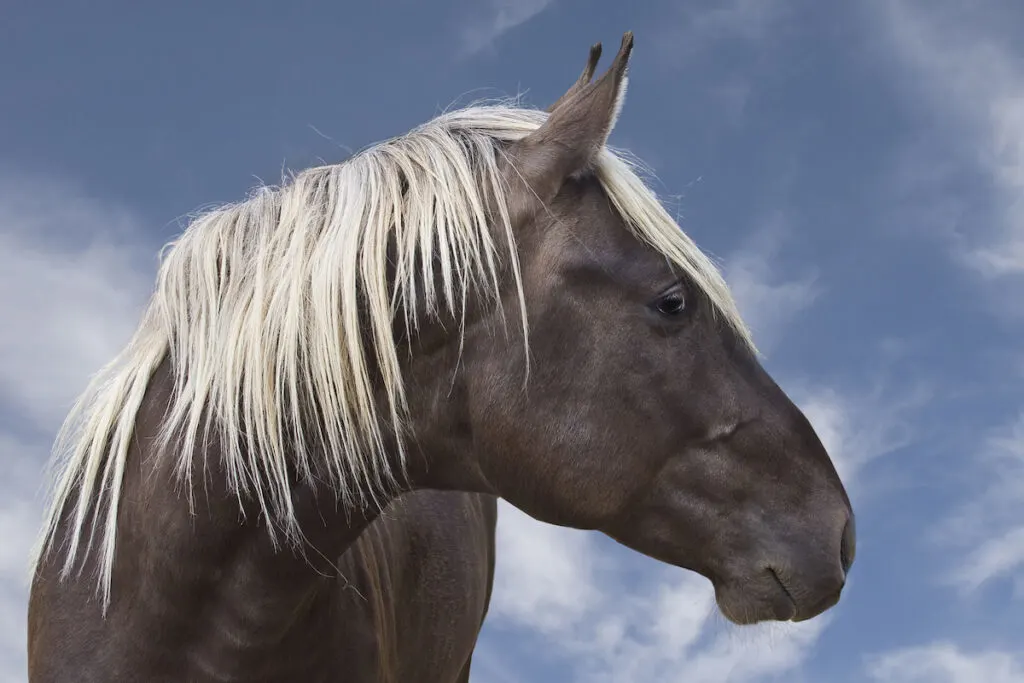
Table of Contents
History of the Rocky Mountain Horse
Although the name suggests that this horse is named after an origin in the Rocky Mountains, this breed did not originate from the Rocky Mountains.
The Rocky Mountain horse has its origins in the Appalachian Mountains of Kentucky and Tennessee in the United States.
The first documented mention of the Rocky Mountain horse was in the late 1800s when settlers in the area began to crossbreed their native ponies with draft horses brought over from Europe.
An anonymous traveler came to the area with a young, gaited, chocolate-colored colt. This colt had a striking blonde mane and tail (flaxen in equine terms).
He traded his colt for supplies, and the colt was bred with local mares, including the American Saddlebred and Tennessee Walking Horse.
This crossbreeding resulted in a hardy, sure-footed horse well-suited for mountain life.
The Rocky Mountain horse became popular as a pack animal and soon spread throughout the region.
In the early 1900s, Kentucky State University began developing a breeding program for the Rocky Mountain horse, and by the mid-1900s, the breed had gained national attention.
The Rocky Mountain Horse Association was formed in 1986 to preserve the purity of the breed, and at its first opening, it registered 26 horses.
Today, an estimated 25,000+ Rockies exist, and they can be found in almost every US state.
Quick Facts
| Breed Name | Rocky Mountain horse |
| Other names | Rocky |
| Characteristics | Adaptable, willing to please, easy to train. |
| Temperament | Docile, friendly, patient. |
| Color | Chocolate/dark-brown, all solid colors. |
| Height | 14.2–16 hands |
| Weight | 850–1,000 lbs. |
| Lifespan | 30–37 years |
| Uses | Trail riding, animal packing, therapy riding, sports—Western and English. |
| Country of Origin | United States of America (Kentucky) |
| Association/ Registry | Rocky Mountain Horse Association (RMHA) |
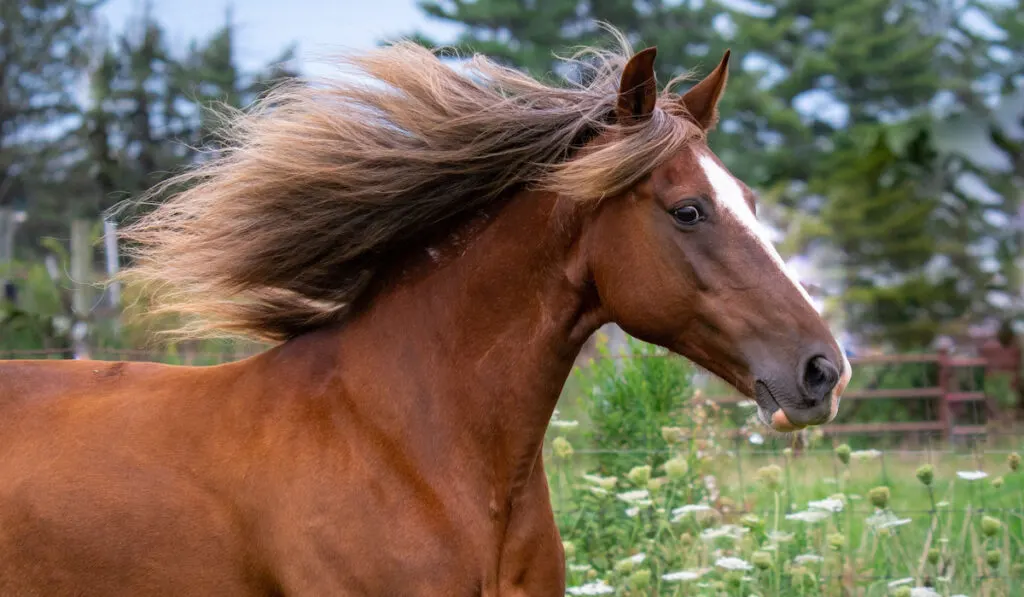
Breed Characteristics
The Rocky Mountain Horse is a medium-sized horse.
A typical Rocky has a long head, a straight profile, and large expressive eyes. The ears are medium-sized and pointed, and the neck is muscular and medium length.
It has a compact and well-proportioned body, with medium-length legs that are thick and muscular.
These equines stand between 14.2 and 16 hands high and have a strong, balanced build. The chest is deep and wide, the shoulders are slightly sloped, and they have a short back.
Their coat is dense and can be any solid color, but the most preferred coat is chocolate. They also have a flaxen mane and tail that’s thick and full.
Rockies are sure-footed and nimble, making them ideal for trail riding.
They have sturdy legs with well-defined muscles that allow them to carry riders over long distances without tiring.
They can often cover at least 11km/hr (7 miles/hr) in rough or rocky terrain and about 26km/hr (16 miles/hr) on level ground.
Today, Rocky Mountain horses are still used for cattle drives and trail riding, but they also excel in other disciplines such as dressage, show jumping, and eventing.
If you’re looking for a beautiful and versatile horse, then the Rocky Mountain horse might be the breed for you!
Size, Weight, and Lifespan
Rockies are a medium-sized breed, weighing between 850 and 1,000 lbs. The average lifespan of the Rocky Mountain horse is 30 years, though some may live even longer.
With good care and nutrition, it’s not uncommon for a Rocky to live past the age of 30.
One of the longest-living Rockies, Samuel Tully’s Old Tobe, a prominent foundation sire of this breed, lived over 37 years!
If you’re considering adding a Rocky to your family, be prepared to enjoy many years of companionship with this special breed.
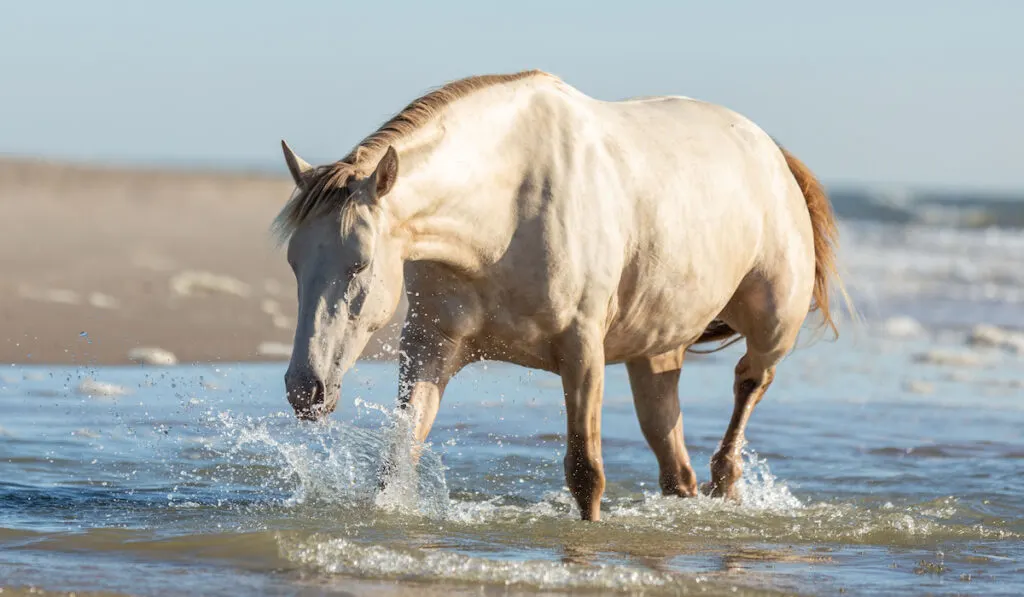
Colors and Markings
One of the most distinguishing features of the Rocky Mountain horse is its coat color.
Most Rockies are chocolate-colored or brown with a flaxen mane and tail. The flaxen mane and tail are created by a silver dapple gene unique to this breed.
However, Rockies can also come in
- Black
- Bay
- Chestnut
- Palomino
- Gray
- Roan
According to the RMHA, a horse cannot be registered as a Rocky if it has any white patches or markings above its hocks.
The registry does not contain any horses that are spotted, paint, or entirely white. All horses must be solid-colored to be registered and certified.
Temperament of the Rocky Mountain Horse
The Rocky Mountain horse is calm, gentle, and very approachable.
These horses are intelligent and willing partners that thrive on human companionship. Rockies are often the go-to breed for the elderly, young, and inexperienced riders. This is due to their gentle and patient disposition.
Rockies are also adaptable and reliable, which makes them an excellent choice for those looking for a dependable mount.
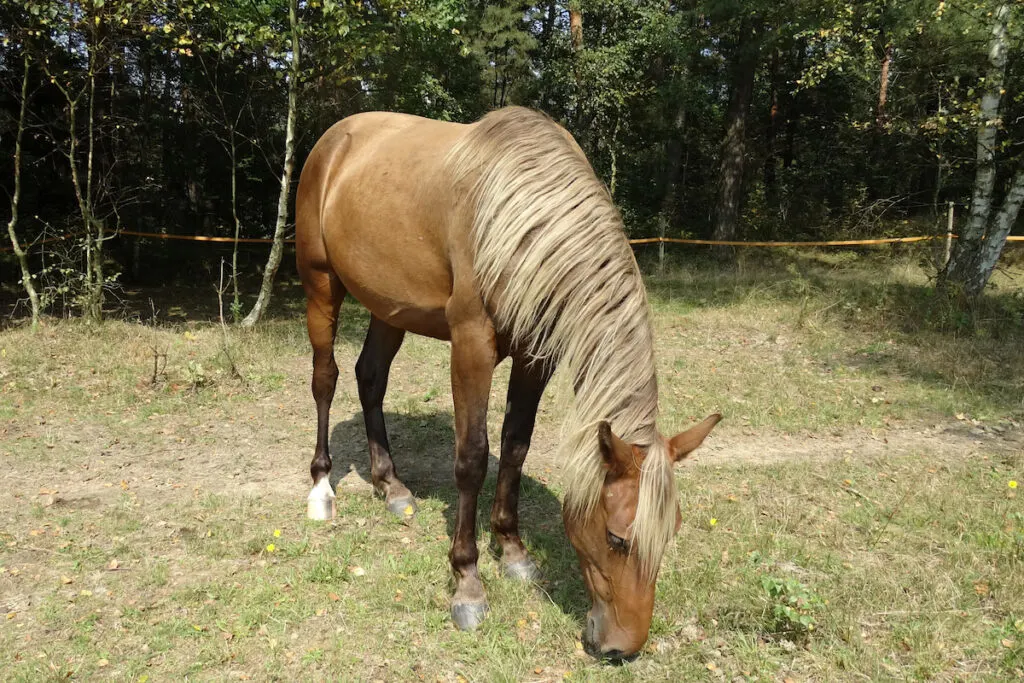
Uses of the Rocky Mountain Horse
The Rocky Mountain horse is versatile and can be used for various purposes.
Rocky Mountain horses are often used as trail horses, packing horses, and even therapeutic riding horses. They are very responsive to training and make excellent pleasure, show, and work ranch horses.
Because of their gentle nature and abilities, they are the ideal training horses.
Their calm demeanor and sure-footedness make them well-suited for many different types of riders.
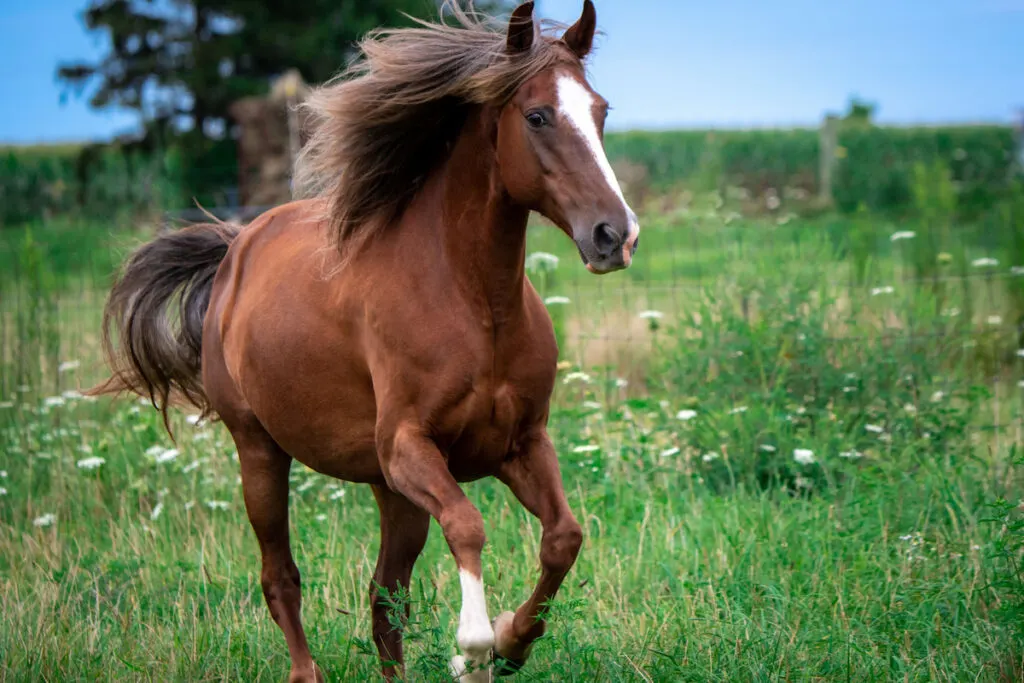
What’s the Difference Between a Rocky and Other “Mountain” Horses?
The Rocky Mountain horse is a gaited horse breed.
Gaited horses are known for their smooth, comfortable way of moving, and the Rocky is no exception.
Its unique gait sets the Rocky apart from other Mountain horse breeds.
Rockies don’t trot. They have a natural gait which includes a smooth-running walk and comfortable canter.
The Rocky Moutain horse’s gait is a four-beat lateral ambling gait called the “single-foot” gait, which is both comfortable and easy to ride.
Each foot hits the ground individually, usually left-hind, left-fore, right-hind, and right-fore (in that order).
This gait is often described as similar to a rocking chair or a wagon wheel rolling down a hill.
How to Care for a Rocky Mountain Horse
Rockies are not high-maintenance horses, but they do require unconditional love and care.
Proper handling and care are not only good for horses, but also helps you prevent additional costs that may arise as a result of neglect and inadequate care.
Here are some tips on how to care for your Rocky:
Feeding
The Rocky Mountain horse is an easy keeper and usually doesn’t require a special diet. However, you should provide good quality hay along with plenty of fresh water.
This breed is prone to obesity, so avoid overfeeding and allow your horse access to pasture or turnout time to prevent weight gain.
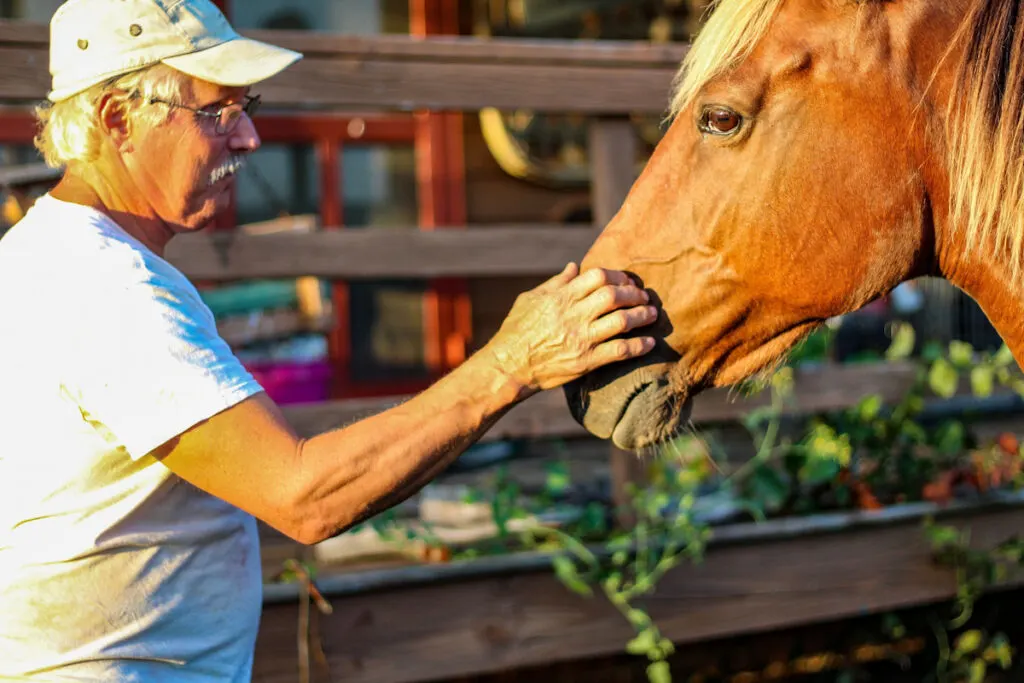
Grooming
Grooming is essential for all horses, especially those with long hair like the Rocky Mountain horse.
It can also facilitate bonding between you and your horse.
Daily brushing will help you remove dirt and debris from the coat and keep it healthy and shiny. It can also help to remove ectoparasites from your horse’s skin.
The mane and tail should also be brushed regularly to prevent tangles and matting.
Exercise
As mentioned before, the Rocky Mountain horse is prone to obesity, so regular exercise is important to keep their weight in check.
A minimum of 30 minutes of daily exercise is recommended, whether it’s turnout time in a pasture or riding on the trails.
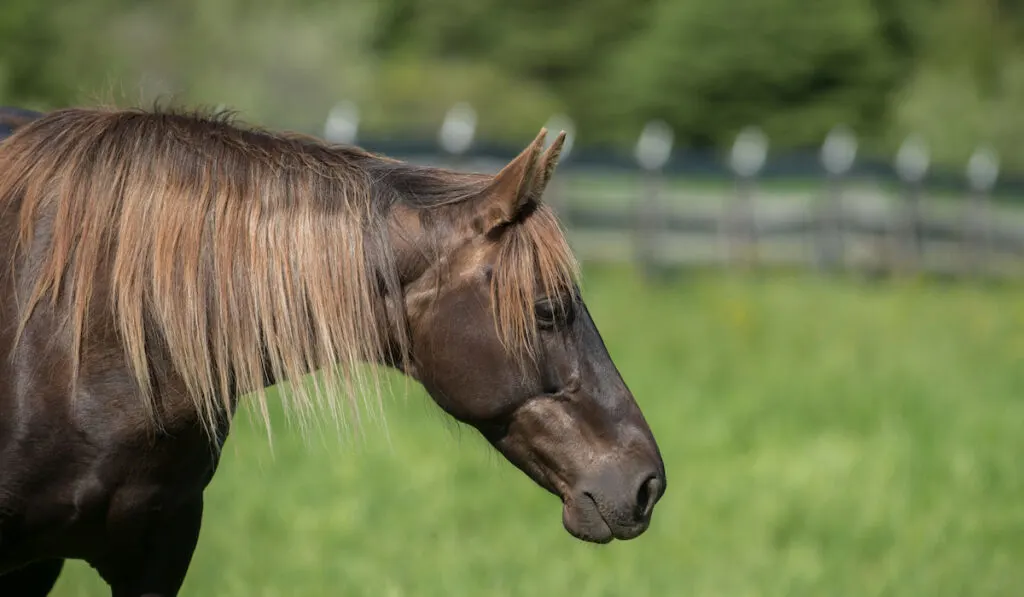
Shoeing
Like all horses, the Rocky will need hoof care in the form of periodic trimming and shoeing.
Your farrier can help you determine how often that should be done.
Conclusion
The Rocky Mountain horse is an incredibly versatile breed that can be used for almost any type of riding or work.
Whether you’re looking for a reliable trail horse, a gentle companion, or something in between, the Rocky Mountain horse can do it all.
With their good looks and willing attitude, this special breed will make a great addition to any family’s stable.
If you’re considering adding one to your barn, you can reach out to a reputable breeder and get familiar with the Rocky’s unique traits before making your decision.
Resources
- https://www.thesprucepets.com/rocky-mountain-horse-breed-profile-4777224#toc-colors-and-markings
- https://www.horsebreedspictures.com/rocky-mountain-horse.asp
- https://www.petguide.com/breeds/horse/rocky-mountain-horse/
- https://www.rmhorse.com/membership/membership-benefits/
- https://breeds.okstate.edu/horses/rocky-mountain-horses.html

